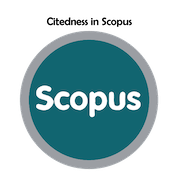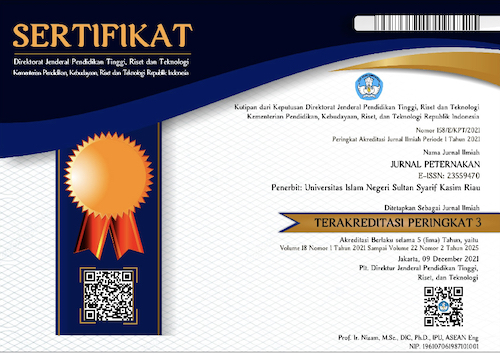Penanganan Ayam Broiler Sebelum dan Sesudah Pemotongan: Studi Pengolahan Daging Broiler di Kota Mataram dan Sekitarnya
Abstract
ABSTRAK. Penelitian bertujuan untuk mengetahui pola penanganan dan pemotongan ayam broiler di kota Mataram dan sekitarnya. Penelitian dilakukan dengan metode surve dan wawancara mendalam serta melakukan pengamatan langsung ke tempat usaha. Sebagai sumber data adalah peternak, pengepul, dan pemotong yang tersebar di kota Mataram dan sekitarnya. Penentuan sampel menggunakan metode Nonprobability Sampling, dengan penentuan peternak dan pengepul menggunakan metode Sampling Insidental, sedangkan penentuan sampel RPA menggunakan metode Snowball Sampling. Peubah yang diamati adalah: a). Karakteristik responden, b). Penanganan di ahir masa pemeliharaan, c). Pola penangkapan dan pemindahan ke boks dan kendaraan angkut, d). Waktu pengangkutan, e) Lama dan jarak pengangkutan, f). Penanganan ayam saat pemindahan dari kendaraan angkut ke tempat karantina, g). Perlakuan pengistirahatan, h). Pelaksanaan penyembelihan. Data yang diperoleh dianalisa secara deskriptif. Hasil penelitian mendapatkan bahwa proses penangkapan dan pengangkutan ayam broiler dari peternak ke tempat pemotongan ayam (TPA) tidak dijumpai adanya pelanggaran Animal welfare, namun ada indikasi pelanggaran di proses pencelupan di air panas setelah penyembelihan. Proses penyembelihan masih belum mengikuti prosudur baku yang ditetapkan oleh Direktorat Kesmavet dan Pasca Panen, dan BSNI, namun sudah mengikuti prosudur baku yang ditetapkan oleh Majelis Ulama Indonesia, sehingga produk yang dihasilkan tergolong daging halal.
Handling of Broiler Before and After Slaughter: Study of Broiler Meat Processing in Mataram City and its Surroundings
ABSTRACT. This study aims to determine the pattern of handling and slaughtering broiler chickens in the city of Mataram and its surroundings. The study was conducted using survey methods and in-depth interviews and direct observations of the place of business. Data were collected from farmesr, distributors, and butchers in the city of Mataram and its surroundings. The samples were determined using the Nonprobability Sampling method. Farmer and distributor were determined using the Incidental Sampling method, while the RPA samples were determined using the Snowball Sampling method. The observed variables were: a). Characteristics of respondents, b). Handling at the end of the rearing period, c). The pattern of catching and transferring of the chickens to boxes and transport vehicles, d). Time of transportation, e) Length and distance of transportation, f). Handling of chickens when moved from transport vehicles to quarantine facilities, g). Rest treatment, h). Slaughter implementation. The data obtained were analyzed descriptively. The results showed that the process of catching and transporting broiler chickens from farmer to chicken slaughterhouses did not violate animal wefare, but there were violation indications when the chickens were put in hot water after slaughtering. The slaughtering process still does not follow the standard procedure set by the Directorate of Veterinary Public Health and Post-Harvest, and BSNI, but has followed the standard procedure set by the Indonesian Ulama Council, so the final product is classified as halal meat.
Keywords
Full Text:
PDF (Bahasa Indonesia)References
Ajakaiye, J.J., J.O. Ayo & S.A. Ojo, 2010. Effects of heat stress on some blood parameters and egg production of Shica Brown layer chickens transported by road. Biol. Res. 43: 183-189.
Al-Aqil, A. & I. Zulkifli, 2009. The changes in heat shock protein 70 expression and blood characteristics in transported broiler chickens as affected by housing and early age feed restriction. Poult. Sci. 88:1358-1364.
Al-Fataftah, A.A. & Z.H.M. Abu-Dieyeh, 2007. Effect of chronic heat stress on broiler performance in Jordan. Int. J. Poult. Sci. 6 (1): 64-70
Al-Ghamdi, Z.H., 2008. Effects of commutative heat stress on immune responses in broiler chickens reared in closed system. Int. J. Poult. Sci. 7(10): 964-968.
Al-Mundziri Z.A. 2008. Ringkasan Shaheh Muslim. Diterjemahkan oleh: Syinqity Djamaluddin. Penerrbit Mizan. Bandung.
Ali Md. S, G.H. Kang & S.T. Joo. 2008. A Review: Influences of Pre-slaughter Stress on Poultry Meat Quality. Asian-Aust. J. Anim. Sci. Vol. 21 (6): 912 – 916.
Barbut, S., A.A. Sosnicki, S.M. Lonergan, T. Knapp & D.C. Ciobanu et al., 2008. Progress in reducing the Pale, Soft and Exudative (PSE) problem in pork and poultry meat. Meat Sci., 79: 46-63.
BSN. 1999. Rumah Pemotongan Unggas. Badan Standarisasi Nasional Indonesia. SNI 01-6160-1999.
Consalesius, A.N., I.R.D. Annytha, & A.W. Diana, 2014. Pengkajian Residu Tetrasiklin dalam Daging Ayam Pedaging, Ayam Kampung dan Ayam Petelur Afkir yang Dijual di Kota Kupang. Jurnal Kajian Veteriner. 2(2):175-181.
Direktorat Kesmavet dan Pasca Panen. 2010. Pedoman Produksi dan Persyaratan Daging Unggas yang Higienis. Ditjen Peternakan dan Kesehatan Hewan. Jakarta.
Doktor J. & K. Połtowicz, 2009. Effect of transport to the slaughterhouse on stress indicators and meat quality of broiler chickens. Ann. Anim. Sci. 9(3):307–317.
Etikaningrum & S. Iwantoro. 2017. Kajian Residu Antibiotika pada Produk Ternak Unggas di Indonesia. Jurnal Ilmu Produksi dan Teknologi Hasil Peternakan. 5(1):29-33.
Ewing SA, Donald C, Lay Jr, & Von Borrel E. 1999. Farm Animal Well-Being: Stress Physiology, Animal Behaviour, and Environmental Design. Printice Hall.
Haq, A. 2006. Formulasi Nalar Fikih: Kaidah Fikih Konseptual, Khalista.Surabaya.
Jayaprakash G,. M. Sathiyabarathi, M. Arokia Robert & T. Tamilmani. 2016. Transportation Stress in Broiler Chicken. Internat. J. Sci. Environ and Technology. 5(2): 806 – 809.
Lengkey, H.A.W., J. A., Siwi1, P. Edianingsih, & J. Nangoy. 2013. The Effect of Transportation on Broiler Meat pH and Tenderness. Biotec. Anim. Husban. 29 (2):331-336.
Lin H., H.F. Zhang, R. Du, X.H. Gu, Z.Y. Zhang, J. Buyse, & E. Decupere. 2005. Thermoregulation responses of broiler chickens to humidity at different ambient temperatures. II. Four weeks of age. Poult Sci 84:1173-1178.
MUI. 2009. Standar Sertifikasi Penyembelihan Halal. Fatwa Majelis Ulama Indonesia Nomor 12 Tahun 2009 Tentang Standar Sertifikasi Penyembelihan Halal.
Moberg G.P., 2000. Biological response to stress: Implications for animal welfare. In: G. P. Moberg and J. A. Mench (ed). The Biology of Animal Stress. CABI Publishing, UK. Pp 1–21.
Trivedi K & Bhargava, 2010. Relation of creativity and educational achievemen in adolelescence. J. Psychology. 1(12):85-89.
Tamzil M.H., 2014. Stres Panas pada Unggas: Metabolisme, Akibat dan Upaya Penanggulangannya. Wartazoa. 24(20):57-67.
Tamzil M.H., B. Indarsih & I.N.S. Jaya . 2019. Rest Before Slaughtering Alleviates Transportation Stress and Improves Meat Quality in Broiler Chickens. Int. J. Poult. Sci., 18 (12): 585-590.
Tamzil, M.H., B. Indarsih & I.N.S. Jaya, 2018. Water Spraying Prior to Transportation Reduces Transportation Stress and Maintain the Meat Quality of Broiler Chickens. Pak. J. Nutr. 17 (11): 550-556.
Tamzil M.H., N.K.D. Haryani & B. Indarsih, 2016, Reduced Expression of Heat Shock Protein (HSP) 70 Gene by Ascorbic Acid Supplementation in Broiler Chickens Exposed to Transportation Stress to Maintain the Quality of Meat and Hematological Parameters. Int. J. Poult, Sci., 15 (11): 432-441.
Yulianti, N.T., N. Ariyani, Nurhidayah, & E. Nugraha. 2016. Kajian Residu Antibiotik Golongan Tetrasiklin dan Penisilin dalam Daging, Hati, Usus dan Paru-paru Ayam Broiler di 13 Provinsi di Indonesia. Buletin Pengujian Mutu Obat Hewan No.25.
Zhang L, H.Y. Yue , H.J. Zhang, S. G. Wu, H.J. Yan , YS. Gong, & G.H. Qi. 2009. Transport stress in broilers: I. Blood metabolism, glycolytic potential, and meat quality. Poult Sci. 88(10):2033-41
Zulkifli, I., A. Al Aqil, A.R. Omar, A.Q. Sazili & A. Rajion, 2009. Crating and heat stress influence blood parameters and heat shock protein 70 expression in broiler chickens showing short or long tonic immobility reactions. Poult. Sci. 88:471-476.
DOI: http://dx.doi.org/10.24014/jupet.v18i1.11759
Refbacks
- There are currently no refbacks.
Jurnal Peternakan has been accredited by Sinta 3 : Number 158/E/KPT/2021
Starting from Vol. 18 No. 1 Year 2021 to Vol. 22 No. 2 Year 2025
Jurnal Peternakan Indexed By:
Editorial Office:
Jurnal Peternakan
Faculty of Agriculture and Animal Science, State Islamic University of Sultan Syarif Kasim Riau.
H.R. Soebrantas street KM. 15,5 Panam – Pekanbaru city.
E-mail: jurnal.peternakan@uin-suska.ac.id
ejournal: http://ejournal.uin-suska.ac.id/index.php/peternakan

Creation is distributed under the Creative Commons Attribution 4.0 International License. View Mystats














